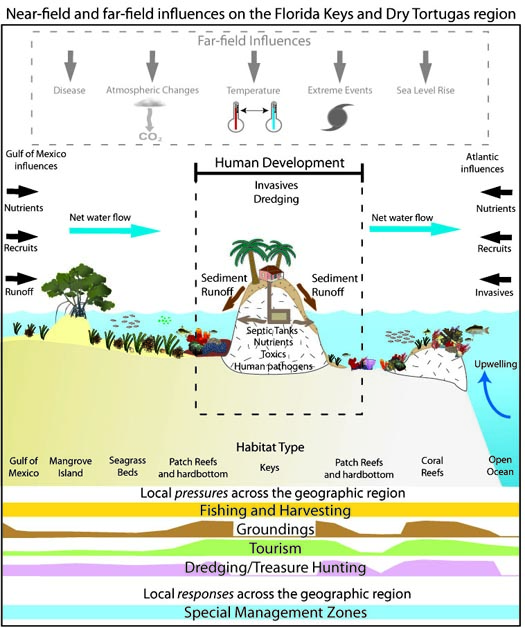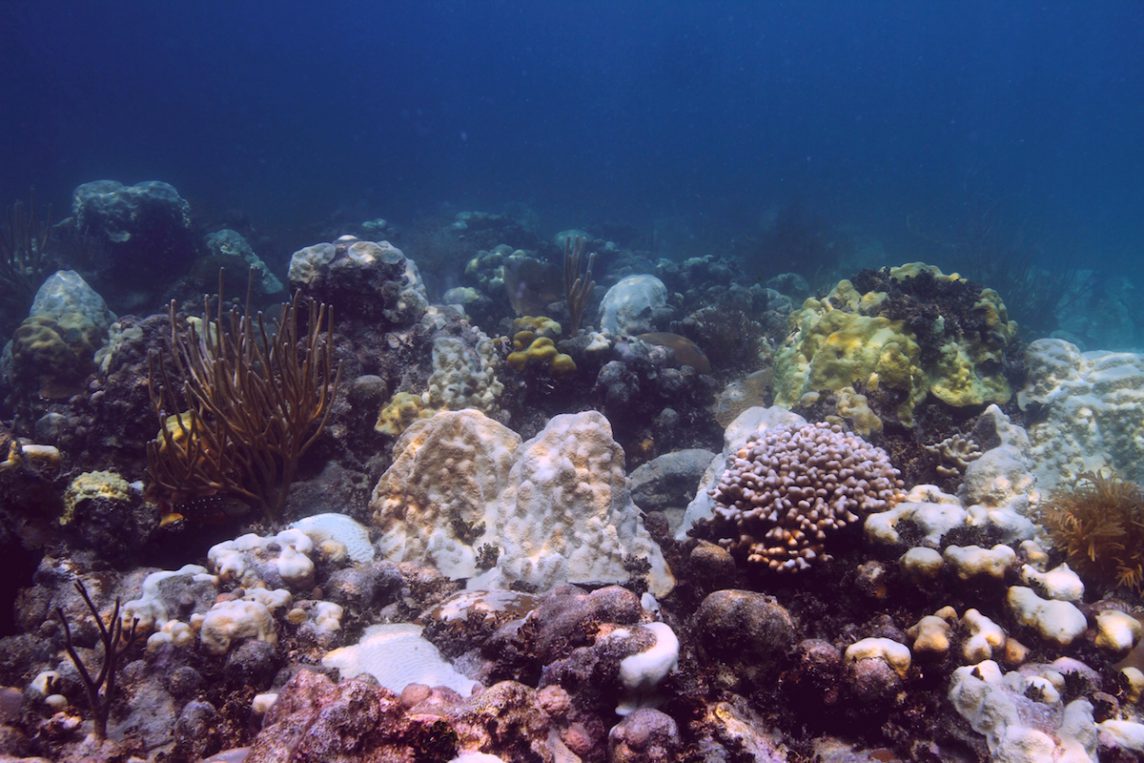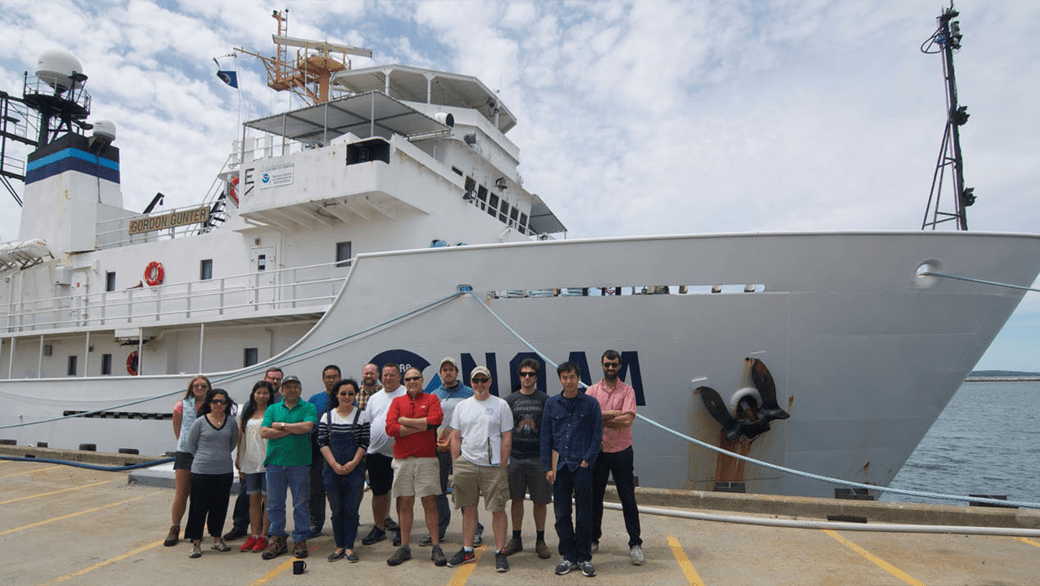In a paper published in the Journal of Operational Oceanography, a team of scientists with the Physical Oceanography Division at AOML, the University of Santiago de Compostela in Spain, the University of Miami, the University of Hawaii, and the Commonwealth Scientific and Industrial Research Organisation (CSIRO) of Australia analyzed possible pathways to link the location of the found debris in the southwestern Indian Ocean with potential crash sites, probably in the eastern Indian Ocean.
AOML Leads Research Efforts Across Caribbean to Improve Bleaching Predictions
For the third time in recorded history, a massive coral bleaching event is unfolding throughout the world’s oceans, stretching from the Indian Ocean to the Caribbean. Above average sea surface temperatures exacerbated by a strong El Niño could result in the planet losing up to 4,500 square miles of coral this year alone, according to NOAA. The global event is predicted to continue to impact reefs into the spring of 2016.
AOML Joins Ocean Acidification Program Research Cruise Along U.S. East Coast
A team of researchers, including scientists from AOML and the University of Miami, set sail June 19th on a research cruise aboard the NOAA ship Gordon Gunter to provide increased understanding of ocean acidification and its drivers along the U.S. East coast. The cruise, which is part of a larger effort supported by NOAA’s Ocean Acidification Program, investigated near-shore and deep waters, and provided researchers with more detailed information about changing ocean chemistry in different environments.
Ocean acidification is a fundamental change in ocean chemistry involving a progressive decline in pH over decades caused primarily by the absorption of increasing carbon dioxide emissions. Additionally, freshwater and nutrient run off from the coasts can alter seawater chemistry. The rise in dissolved CO2 and concurrent drop in pH (lower pH indicates higher acidity), changes ocean chemistry in a way that robs marine organisms, such as mollusks and corals, of the carbonate ions they need to build shells and skeletons. At the same time, the increasing acidity can erode the structures they’ve already built, and appears capable of disrupting their bodies in other ways that make it hard for them to thrive.
The Gunter traveled north from Newport, RI to survey the waters of the Nova Scotia Shelf and then steamed south, surveying waters close to shore to provide detailed information about water chemistry within the Gulf of Maine, Long Island Sound, the Mid-Atlantic and Southern Bight regions. The ship also investigated central Florida waters before reaching Miami on July 24. Similar Ocean Acidification Program cruises have taken place on the U.S. West Coast and the Gulf of Mexico. Understanding why and how fast ocean chemistry is changing along our coasts will allow scientists to better predict future changes, explore ways to adapt to those shifts, and provide insight into where marine organisms may be at greatest risk along U.S. coasts.
AOML researchers measured inorganic carbon dioxide, partial pressure of carbon dioxide, and collect nutrient samples to be analyzed later at AOML. By collecting and analyzing samples in near-shore and deeper waters, scientists will better understand what drives the process of ocean acidification in different regions of the East Coast. The East Coast has a broad shallow shelf, which could be a significant source of potentially corrosive, freshwater discharge from rivers into the coastal ocean. Sampling along the coast will allow scientists to understand how fresher waters, coastal influences, and phytoplankton may alter our ocean chemistry. This environmental information about ocean acidification is essential to predicting its effects on important marine resources, so that communities can mitigate and adapt to these changes.
New Tools Bring Ecosystem Benefits to the Forefront of Decision Making
The Marine and Estuarine Goal Setting for South Florida (MARES) project, led by NOAA’s Cooperative Institute for Marine and Atmospheric Studies at the University of Miami, continues to increase awareness of and appreciation for the value of coastal marine ecosystems, and their impacts upon human society. From 2009 through 2013, NOAA’s National Centers for Coastal Ocean Science funded MARES with the goal of creating a consensus-based process for managing South Florida’s coastal marine environments. MARES is unique in that it was among the first major efforts to include human benefits in a systematic framework to enable integrated ecosystem based management. The MARES approach embodies NOAA’s effort to serve as the Nation’s environmental intelligence agency by providing actionable information from science-based models to support environmentally-sensitive decisions made every day by individuals, communities, and governments.
“NOAA took a leadership role in funding the MARES project, and it is a step in the right direction”, said Eric Millibrandt, director of the Marine Laboratory at Sanibel. “I’ve used the concepts provided by MARES to help colleagues and non-technical individuals to better understand the ecosystem and its preservation.”
When natural resource managers make decisions, it is important that they take both the needs of the environment, as well as human population requirements and perspectives into consideration. This integrated approach is necessary to sustain a physically and economically balanced and healthy ecosystem. Coastal populations rely on and interact with their unique marine and estuarine flora and fauna on a daily basis.
In the last century, increased population, coastal development, climate change and sea level rise have damaged South Florida’s marine environment. As these changes continue, the long-term status of South Florida’s ecosystems and valuable resources will continue degrading. The coastal habitat is crucial to the regional economy, which relies on ocean related jobs such as, fishing and tourism. Since a healthy ecosystem is needed for economic survival, the interactions between Florida’s population and the ecosystem is important and can be used to help guide the management decisions regarding South Florida’s coastal ecosystems.
Typically, research and management on marine ecosystems have focused primarily upon the negative impacts humans have on the environment. MARES investigators realized that for citizens to embrace marine policy, it is essential they understand not only the variety of pressures on the system, but the benefits they derive from it and their role within it. Over 50 researchers (both natural system and human dimensions scientists), managers, and stakeholders collaborated to understand and document cause and effect relationships and the societal benefits of South Florida’s coastal marine environments. By studying coastal waters in the Florida Keys/Dry Tortugas, the Southeast Florida Coast, and on the Southwest Florida Shelf, MARES was able to reach a consensus as to which regulating processes were most significant and which key characteristics must be sustained. The MARES team is publishing their findings in 15 research papers in a special issue (volume 44) of the journal Ecological Indicators entitled: “Tools to support ecosystem based management of South Florida’s coastal resources.”
The tools MARES developed are currently being used in community planning projects to show the existing status of the marine environment and to incorporate human benefits in ecosystem management. One of the most popular MARES products used by resource managers are the conceptual diagrams designed for the Southwest Florida Shelf, Southeast Florida Coast, and the Dry Tortugas/Florida Keys.

MARES conceptual diagram showing connections between FL Keys and Dry Tortugas
Additionally, NOAA’s National Marine Sanctuaries are evolving to include the MARES conceptual model framework in their guidelines. Sanctuaries’ Condition Reports currently provide a summary of resources in the Sanctuaries, pressures on those resources, the current condition and trends, and management responses to the pressures that threaten the integrity of the marine environment. Specifically, the current Condition Reports include information on the status and trends of water quality, habitat, living resources and maritime archaeological resources and the human activities that affect them. Future reports will be based on the MARES DPSER (Driver, Pressure, State, Ecosystem Services, Response) Model to clearly document ecosystem benefits to the public.
“MARES products and tools helped show us we need to integrate ecosystem services into our next generation of Conditions Reports said Bob Leeworthy, chief economist for NOAA’s Office of National Marine Sanctuaries. “These Next Generation Condition Reports will emphasize the value of services provided by ecosystems, all as a result of the MARES project.”

